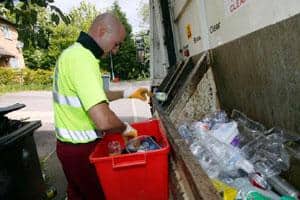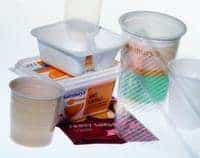In its summary of the work, WRAP claimed that the research presented a “strong case for developing mixed plastic recycling in the UK”.
Work on the economic viability of mixed plastic recycling comes as part of WRAP's continued work to increase mixed plastic recycling infrastructure in the UK by at least 40,000 tonnes-a-year by 2011.
Marcus Gover, director of market development for WRAP, said: “This material is an extremely visible part of the domestic waste stream, and householders are increasingly asking whether it can be collected and recycled in the same way as other packaging materials such as glass, plastic bottles and cans.
“Like other waste streams, mixed plastics packaging has a value as a secondary material and it does not make economic or environmental sense to dispose of it in landfill.”
The research work, which was commissioned in October 2008, was carried out by a consortium led by consultancy company Nextek Ltd and included supermarket Sainsbury's, compliance and recycling company Valpak, business consultant Bowman Process Technology, recycling firm Closed Loop Recycling, plastic reprocessor LINPAC and plastics recycling firm CeDo (see letsrecycle.com story).
Cost
Any strategy to increase mixed plastics packaging recycling within collections should focus first on authorities using single or two stream commingled collection systems specifically with spare container capacity or on kerbside sort authorities re-tendering contracts and thus able to introduce new vehicle designs
WRAP
Drawing on the fact that plastic packaging comprises 9% of waste collected at the kerbside, WRAP claimed that almost 7% of this was classed as ‘mixed' (rigid and flexible plastics such as tubs, yoghurt pots and films) and, in the first report, the research assessed the financial implications for local authorities to add mixed plastic to their existing collections.
The study, entitled 'The financial costs of collecting mixed plastics packaging', claimed that the lowest additional cost would come from using bring sites for the mixed plastic material but this would not be cost effective overall, as it would produce a lower yield than collecting directly from the household. And, despite it costing more to add mixed plastics to kerbside sort systems, it found that this would have lower overall costs than collecting it with commingled collections because it would not have to go through a materials recycling facility (MRF).
The research found that adding mixed plastics to an existing commingled collection would produce an incremental collection-only cost of £130 to £149 per tonne if only rigid plastic packaging was added and £206 to £232 per tonne if it was rigid plastic and plastic film. This was compared to dual-stream systems, which would cost an extra £74 to £104 per tonne for rigid plastic and £150 to £217 per tonne for rigid plastic and film.
When looking at the use of bring sites for mixed plastic collection, the report claimed that it would cost local authorities between £32.36 and £220.93 per tonne for rigid plastics only and £42.42 and £150.45 per tonne for rigid plastics and additional items such as plastic film.
Kerbside sort
Comparatively, adding rigid plastic packaging to a source separated collection system would add between £239 to £268 per tonne for rigid plastic for councils using alternate weekly collections and £287 to £334 per tonne for weekly collections. This was compared to £44 to £217 per tonne for rigid plastics and film.
However, WRAP claimed that there was “inevitable uncertainty” in the processing costs for mixed plastics collected via commingled or dual-stream routes, as local authorities would have to pay a gate fee for it to be sorted by a MRF.
In the executive summary of the report on financial costs, WRAP explained: “Any strategy to increase mixed plastics packaging recycling within collections should focus first on authorities using single or two stream commingled collection systems specifically with spare container capacity or on kerbside sort authorities re-tendering contracts and thus able to introduce new vehicle designs.”
In addition, WRAP claimed that any authorities unable to “take advantage of these situations” may want to consider developing bring systems possibly in collaboration with retailers.
Technical
The consortium then worked with 26 businesses across the UK to reprocess 150 tonnes of mixed plastic packaging to assess the technical challenges in reprocessing the material in a report entitled 'Commercial scale mixed plastics recycling'.
Using three MRFs at different locations in the UK, the research found “large quantities” of the material could be recovered when collected commingled and it did not adversely affect the quality of other material collected for reprocessing.
In addition to working with MRFs, the study investigated the use of PRFs – plastic recovery facilities – to recycle mixed plastic in a dedicated plastic recycling operation. The research, which drew on trials carried out in the UK, The Netherlands, Germany and Austria, recommended that the use of an integrated PRF and a reprocessor would be “more efficient and would produce less residual waste”.
The report claimed that the combined PRF and reprocessor on one site could achieve material recovery of between 55-60% and, echoing claims made previously by WRAP, the report explained that any residual waste left over from the plastic recovery operation had “potential for use as Solid Recovered Fuel”.
Investigating the role that retail take-back could play in increasing mixed plastics recycling, the study showed that store collection trials “have the potential to play a valuable role” as long as facilities were well designed. And, it also claimed that store take-back schemes present low levels of contamination, in terms of non-plastic packaging such as glass, paper and steel.
The overall conclusion from the research into commercial scale recycling found that recycling mixed plastic was “technically viable on a commercial scale”.
Commercial
In a third report, entitled 'A financial assessment of recycling mixed plastics in the UK', WRAP claimed that if mixed plastics were to be collected and recycled it was “essential” that sorting and reprocessing facilities were in place and able to operate on a commercial scale.
After assessing the various scenarios of MRF sorting – with one facility sorting plastic bottles but not mixed plastic, one sorting plastic bottles and rigid mixed plastics as well as glass, and another handling mixed plastic but not glass – and setting up an integrated plastics facility, which combined a PRF with further reprocessing, the study deemed mixed plastic recycling commercial viable if done on a “large enough scale”.
In a bid to ensure that “essential” infrastructure for mixed plastic recycling is in place in the UK, WRAP also used the event to launch a £2 million capital grant programme to help develop mixed plastic recycling capacity in the UK.
The scheme, recycling companies eligible for support in England, Wales and Northern Ireland will be able to claim up to 30% of the finance required to develop and expand their recycling service.









Subscribe for free